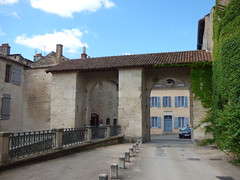Le Porte d'Honneur Les arcs de la porte double en plein cintre sont à deux rouleaux ; le second, très mouluré, est soutenu par des colonnettes engagées aux cannelures droites et torses, inversées pour chaque baie. Leurs chapiteaux corinthiens sont de très belle facture et témoignent des productions des meilleurs sculpteurs des années 1120-1130. Les baies, autrefois munies de grands vantaux de bois, sont cantonnées de pilastres cannelés des maçonneries, un étage d'attique. Cette composition fut sans doute voulue à l'image des portes antiques. Quelques années après son édification la porte fut transformée en porterie. Située au devant de la grande église abbatiale, elle devait être utilisée pour le cérémonial d'entrée des grands visteurs, avant que ceux-ci ne soient accueillis par l'abbé de Cluny. Au XVIe siècle, sous l'abbatiat de Claude de Guise, celle-ci fut transformée et augmentée d'un second niveau. Le tout était surmonté d'un haut comble en pavillon à l'élévation vertigneuse.
Rue de l'Abbatiale, Cluny
Google Streetview
OpenStreetMap
Subject
Porte d'Honneur
gate
gate


